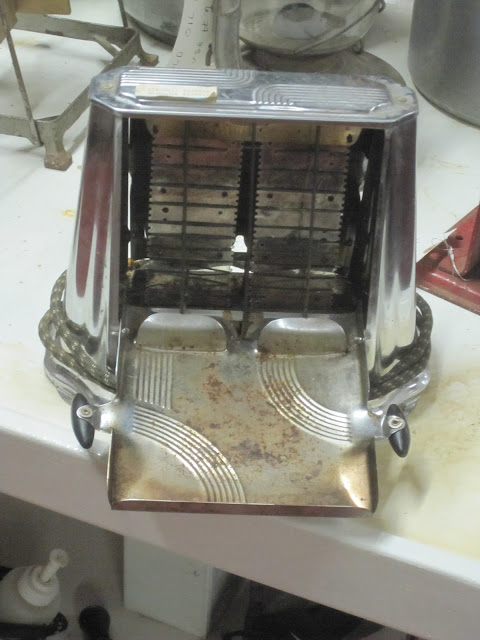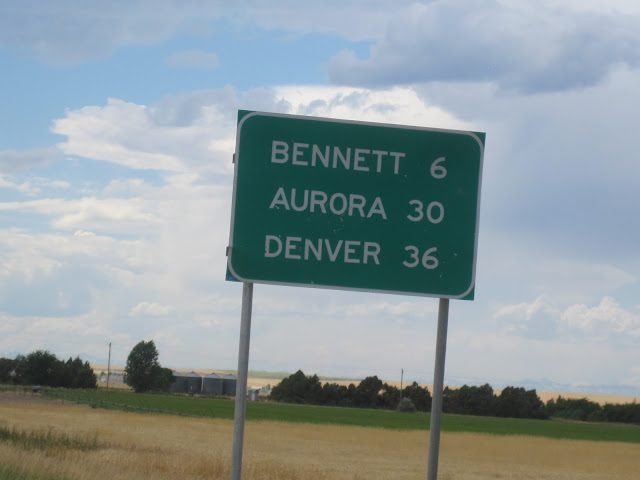
When we got into town, we decided to drive around a little bit before heading to the museum. That turned out to be a good choice. We happened upon a field that was full of old tractors. I was very intreagued by all the tractors, so had Steve pull over so we could take a closer look. We didn't think that anyone would mind if we walked into the field to look at all of the tractors, so we took a look around, and soon noticed a man stating in the work shop. He quickly noticed us and waved us in. He introduced himself as Russ Englebrecht. He said that he has been interest in tractors since he was a small boy. He used to build model tractors when he was young, and then when he was 14, he started working on the real ones. He takes pride in restoring old tractors and keeping them running. His collection is amazing!
As we were walking around looking at all of his tractors, he pointed us in the direction of his barn. He said to take a look at the irrigation system that was leaning up against the wall of the barn. It was the first self propelled irrigation system ever invented, and it was invented by his dad. If you take a close look, it is very similar to the self propelled systems that in use today. Amazing!
After we looked at the irrigation system, we headed to the door of the barn as he had directed us to do. His barn was an old cinder block building with big steel sliding doors, and inside the barn were many of he old tractors he had restored over the years.
 |
| Look at the beautiful ceiling on this old barn |
When we finished looking around the barn, we headed back to the work shop where we met up with Russ again. He showed us some of the tractors that he is working on now.
This one is his pride and joy. It is a completely restored 1924 John Deere. He says this one alone is worth well more then $100k! It was such an honor for us to be able to look at this beautiful piece of history up close. And even more to talk with Russ!
When we left Russ' workshop, we took a few more pictures of his collection and then headed on down the road to find some lunch. Russ had recommended two places to us. The first was KT's BBQ. He said to definitely go there if it was open, but if not, we should stop in at Rookies.
Our first stop was KT's, but to our dismay, it was closed.
So we headed over to Rookies instead. It's a cute little place right across the street from KT's.


Since we hadn't been here before and weren't sure what to order, so we went with the advice of our very nice server Dawne'. Steve ordered a chicken fried steak sandwich and I had a reuben. They were both very good, made just the way you would expect in a small town. Grilled with real butter and served with homemade pickles and sauerkraut. Not something we could eat everyday, but certainly a treat.
Inside the museum, they had collections of all types, and all of the items had been donated the good people in Strasburg. It was pretty amazing.
 |
| This machine was used to put lines on paper |
 |
| Strasburg's first Linotype Machine. You can see the keyboard on the front |
 |
| A Babcock printing press, patented in 1890 and used at the Strasburg newspaper until 1972. |
 |
| The mercantile |
 |
| An armadillo handbag |
 |
| A living room |
 |
| A bedroom |
 |
| The Bank |
 |
| The original school house, Living Springs School, built in 1891 |
 |
| Inside the school house. Desks were set up smallest to largest from front to back |
 |
| Pictures of students from this school house |
 |
| This is a homestead house, built in 1910 |
 |
| Notice the "lace" shelf paper is cut from an old newspaper |
 |
| Another school house, Wolf Creek School, built in 1904 |
After we left the homestead and school houses, we headed to the train depot.
This depot was not yet built when the article below was written, but was build years later and now holds a place in history, as the below newspaper article piece explains:
Comanche Crossing Times, August 15, 1870
On August 15, 1870, the Kansas Pacific Railway joined the first continuous, uninterrupted chain of railroads across the United States from an Atlantic port to a Pacific port. Besides the great feat these two crews broke the previous record by laying 10 miles plus 1320 feet of rails in nine hours. This historic event occurred at Comanche Crossing, Colorado Territory at 2:53 p.m. Under the ownership and direction of the Kansas Pacific, two crews were working toward each other. The eastbound crew was coming from Denver, where they had just completed the Denver-Cheyenne railway and then headed eastward to join the west bound crew.
Comanche Creek, Colorado Territory is now known as Strasburg, Colorado.
 |
| The Strasburg depot, built in 1917 |
 |
| The sticks with strings were used to hand messages from the station to the passing train |
 |
| Calculator and telegraph machine |
 |
| Manual type-writer |
 |
| Filing cabinets |
This depot was also unusual, in that it had housing for the family of the head conductor.
 |
| Notice the curling iron hanging down in the kerosene lantern to heat it |
 |
| Luggage, complete with a closet for hanging and dresser drawers |
 |
| A pump organ |
 |
| Flour storage in the kitchen. The sifter was used for sorting the bugs out of the flour |
 |
| A butter churn |
 |
| A toddler chair |
 |
| A high chair and laundry bucket, board and plunger |
 |
| An ice chest |
Once we were finished at the depot, we headed out to the barn. We couldn't believe that there was still more to see.
 |
| Steve and our wonderful guide, Nancy |
 |
| A corn binder, from 1902-1959. See the description below |
 |
| Grain cleaner - see the description below |

 |
| Plows |
 |
| The barn from the outside |
 |
| Washing machines |
 |
| A pedal sewing machine |
 |
| Rattlesnake rattler Art work |
 |
| Weaving Loom |
 |
| Autos and sleds |
 |
| Stoves |
 |
| Ironing Board |
 |
| Toaster |
 |
| Drill Press |
 |
| A forge for metal working |
 |
| Traps |
 |
| Office Equipment |
 |
| Cash Register |
 |
| A farmer harvesting winter wheat, with all of the old equipment in the foreground |
 |
| Sewing Machines |
 |
| Campfire Girls uniforms |
 |
| 38 stars on this flag |
 |
| Look at the size of this dental chair. They must have been wee little people |
 |
| Telephone operator switchboard. Remember Party lines? |
As we headed home, we decided to take Colfax Avenue at least part way back to Denver. Colfax Avenue runs all the way across Denver, it's suburbs and clear out to Strasburg.
 |
| This is E. Colfax in Strasburg. Not quite a busy as it is in Aurora or Denver |
 |
| We're still on E. Colfax. We honestly didn't realize that it came clear out here. |
 |
| Somewhere out on the eastern plains, someone was getting wet, but we had a beautiful drive all the way home. |





















































































No comments:
Post a Comment